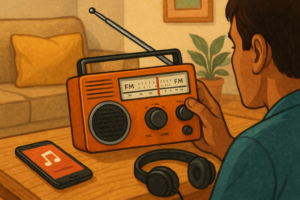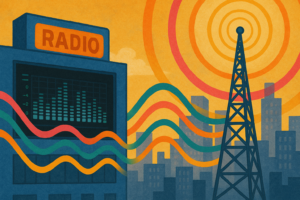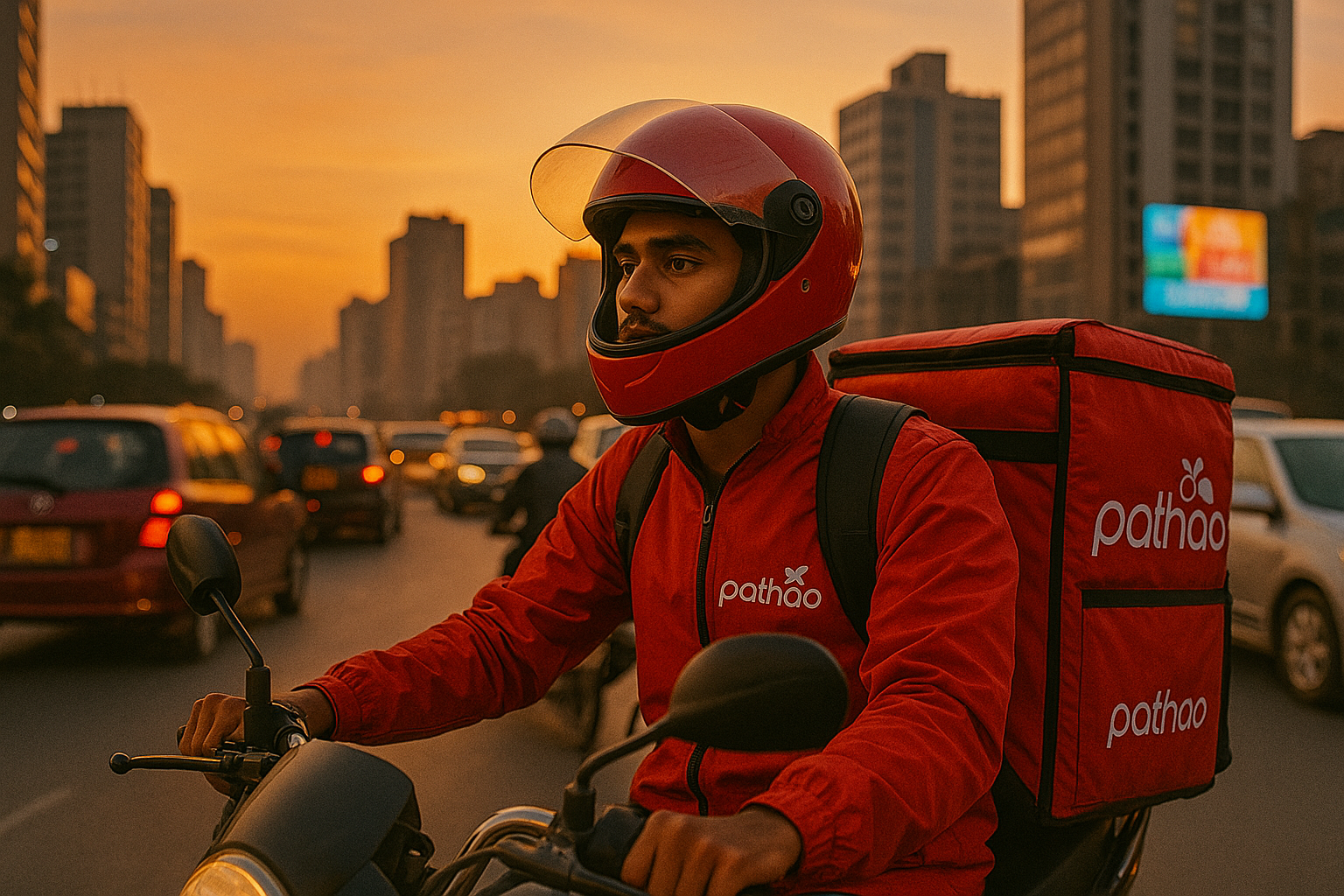Radio’s Quiet Comeback: Is FM Still Relevant in the Digital Age?

FM Radio Strikes Back: Alive in the Digital Soundstorm
In an era dominated by Spotify playlists, YouTube shorts, and endless TikTok scrolls, many wrote off FM radio as a relic of the past. But turn the dial—or swipe to your favorite station—and you’ll find it still alive and well. In traffic jams, roadside tea stalls, rural homes, and even modern offices across Bangladesh, FM radio continues to speak, sing, and connect. Far from fading, it’s evolving—quietly syncing with smartphones, online streams, and social media. FM isn’t just surviving; it’s staging a subtle comeback, proving that in the digital age, relevance isn’t always loud.
The Global Shift: Digital Media’s Takeover
Today, most people listen to music, news, or talk shows on their phones. Streaming services like Spotify, Apple Music, and YouTube, everything is just a tap away. You can choose what to hear, when to hear it, and skip anything you don’t like. It’s fast, easy, and fits into busy modern life.
This digital change is happening all over the world—and Bangladesh is no different. Mostly young people now prefer streaming music or podcasts instead of tuning in to a radio station. Cheap internet and smartphones have made it super simple.
Even talk shows and interviews, which once belonged to radio, are now available as podcasts. People listen to them while walking, working, or traveling.
So, in this fast-paced digital world, one question remains—where does FM radio fit in now?
Bangladesh’s FM Radio Journey: A Brief Overview
FM radio in Bangladesh truly began to take off in the early 2000s. Before that, the only major player on the airwaves was the government-owned Bangladesh Betar. While it played an important role in news, culture, and public service broadcasting, its style was often formal and less engaging to younger listeners.
That changed when private FM stations entered the scene. Radio Foorti, launched in 2006, was one of the first to make a splash. Soon after came Radio Today, ABC Radio, Radio Shadhin, and others. These stations brought something new—popular music, energetic presenters, and a casual tone that spoke directly to a younger generation.
They didn’t just play songs; they created a whole vibe. Morning shows helped people start their day with laughter and traffic updates. Afternoon and evening slots featured live call-ins, birthday wishes, shout-outs, and interactive games. Late-night shows often dealt with emotions, relationships, and confessions, building a sense of connection and trust with the audience.
Listeners began to feel like they knew the radio jockeys (RJs) personally. Catchphrases, signature laughs, and real-time conversations turned many RJs into mini celebrities. FM radio stations became more than just media platforms—they became a part of daily life, especially for students, commuters, and young professionals in urban Bangladesh.

Why Radio Didn’t Die
Despite all odds, FM radio didn’t die. In fact, it adapted. Let’s explore why FM radio is still relevant today—especially in Bangladesh.
1. Accessibility Without the Internet
While mobile internet usage has exploded in Bangladesh, there’s still a significant digital divide—especially between urban and rural populations. According to the BTRC (Bangladesh Telecommunication Regulatory Commission), while over 130 million people have mobile connections, stable and fast internet access isn’t always guaranteed, particularly in remote or disaster-affected areas.
FM radio doesn’t need data. A simple mobile phone with an inbuilt radio, a small radio set, or even public loudspeakers can do the job. It remains the cheapest and most accessible mass communication medium in Bangladesh.
During emergencies—cyclones, floods, or pandemics—when internet services may falter, FM radio becomes a trusted, real-time source of information.
2. Localized and Culturally Rooted Content
Digital media can be global, but FM radio remains deeply local. It speaks the language, understands the festivals, plays regional songs, and reflects the everyday struggles and joys of Bangladeshi life.
From Boishakhi specials to Eid countdowns, traffic updates in Dhaka to debates on Dhallywood gossip, radio captures what’s immediate and relevant.
Stations like Radio Shadhin 92.4 FM have shown highlighting women’s issues, youth voices, and even mental health topics—all through a localized lens. Community radio initiatives in rural areas such as Radio Naf (Teknaf) and Radio Sagor Giri (Sitakunda) amplify local news and grassroots voices that often get drowned out in national narratives.
3. Real-Time Connection and Human Touch
There’s a special kind of thrill when you hear a radio host say, “This next song is for Tumpa from Chittagong—congrats on getting into university!” It’s not just about the music—it’s about being seen and heard.
FM radio gives us something digital platforms often can’t: a real-time, human connection. While Spotify and YouTube may know your taste in music, they don’t know you got a new job today or that you’re missing someone tonight. But a radio host might.
From reading out text messages to chatting live with callers, radio brings people together in the moment. Whether it’s birthday shout-outs, love dedications, or random confessions, the interaction is raw, unscripted, and real.
In a digital world full of autoplay and algorithms, FM radio feels like a friend who actually listens—and responds. That warm, spontaneous human touch? You can’t stream that.
4. FM Goes Digital Too
FM radio hasn’t stayed stuck in the past. Many stations in Bangladesh now stream online, have mobile apps, and maintain active social media pages. Radio Foorti, for instance, offers live streaming on its website and app. Radio Today uploads interviews and special segments on YouTube.
This hybrid model—broadcast + digital—has expanded their reach globally. Overseas Bangladeshis now tune into local radio stations online, staying connected with their culture and hometowns.
Radio presenters also use Facebook Live to interact with audiences, discuss trending topics, and take instant feedback. These integrations have made FM content discoverable and shareable—something previously limited to the broadcast bubble.

5. Trusted During Crises
Trust matters. When rumors flood social media, people turn to sources they can rely on. FM radio, especially stations like Bangladesh Betar during national emergencies, is often perceived as more credible than WhatsApp forwards or fake Facebook posts.
During the COVID-19 pandemic, FM radio in Bangladesh played a crucial role in disseminating health updates, vaccination drives, and safety protocols—especially in regions with limited internet access.
UNESCO and local NGOs have partnered with community radio stations in Bangladesh to run awareness campaigns, educate farmers, and even promote child rights and climate resilience.
Challenges FM Radio Still Faces
While FM radio has survived, it’s not without challenges.
● Shrinking Ad Revenues
One of the biggest hurdles FM radio faces today is the drop in advertising income. In the past, radio ads were a top choice for businesses wanting to reach urban listeners. But now, advertisers are shifting to digital platforms like Facebook, YouTube, and Google Ads—where they can target specific audiences and track every click and result.
This shift has hit Bangladeshi FM stations hard. With fewer businesses buying traditional radio spots, many stations are struggling to cover their operating costs. Some popular shows have seen reduced airtime, and smaller stations are even at risk of shutting down.
To cope, many FM stations have started thinking creatively. Instead of depending solely on ads, they now offer branded content—like sponsored segments, product mentions, and RJ shout-outs. Others partner with companies for event promotions or social media sponsorships, blending radio with digital outreach.
Still, it’s not easy. Competing with data-driven digital ads is tough, and FM radio must constantly adapt to stay financially sustainable in this new media economy.
● Youth Shifting to On-Demand Platforms
Today’s youth want content on their own terms. In cities across Bangladesh, students and young professionals are moving away from traditional FM radio and turning to on-demand platforms like Spotify, YouTube, Apple Music, and podcasts.
The reason is simple: control. On these platforms, listeners can choose what they want, when they want. They can skip a song, replay a favorite track, search by mood or genre, and listen without waiting. It’s a personalized, flexible experience—something FM radio doesn’t always offer.
This shift is a major challenge for radio stations. But instead of giving up, many are looking for smart ways to meet the youth where they already are—online.
Some are now turning their popular talk shows into podcasts that can be streamed anytime. Others are sharing behind-the-scenes content, funny bloopers, or exclusive interviews through YouTube vlogs. Quick, engaging Insta Reels or TikTok clips featuring RJs can also grab attention and keep younger audiences interested.
To stay in the game, FM radio has to do more than just broadcast—it has to blend into digital life.
● Limited FM Frequency in Smaller Towns
While big cities like Dhaka and Chattogram enjoy a variety of FM radio stations, many smaller towns and districts—such as Rangpur, Barisal, Mymensingh, or Sylhet—have limited or no access to private FM broadcasts. In most of these areas, Bangladesh Betar remains the only radio option, often lacking the entertainment-focused, youth-friendly content that private FM stations offer.
This creates a digital divide—not just online, but on the airwaves too. Millions living outside the metropolitan areas miss out on engaging radio content simply because private FM frequencies don’t reach them.
Expanding coverage to these underserved regions is essential if FM radio wants to survive and grow. It’s not just about increasing listener numbers—it’s about giving voice to diverse communities across the country. With better licensing policies and infrastructure investment, FM radio could unlock a whole new audience waiting to be heard.

The Quiet Comeback: Evidence & Examples
Despite the odds, FM radio’s listenership is steady—and in some cases growing.
Radio Foorti’s late-night call-in shows remain some of the most popular programs among Dhaka’s youth.
Community radios in areas like Gaibandha and Barguna have helped farmers with real-time market updates and cyclone warnings.
Live music shows and acoustic jam sessions broadcast over FM still attract a loyal base, proving that not everything has to be on YouTube to be appreciated.
FM radio is now being integrated into ride-sharing services, buses, and CNGs, making it part of everyday commutes.
This quiet persistence is what makes radio’s comeback so remarkable. It isn’t flashy—but it’s consistent, personal, and evolving.
Future of FM in Bangladesh: What’s Next?
The key to radio’s continued survival is innovation without losing its soul. Here’s how Bangladesh’s FM industry can evolve:
1. Go Hyperlocal
To stay relevant, FM stations need to zoom in on local stories. While national platforms focus on big headlines, radio has the power to highlight what’s happening in specific neighborhoods or districts—like traffic updates in Mirpur, a cultural event in Sylhet, or student protests in Rajshahi.
Using local dialects, featuring area-specific news, and interviewing community figures can help stations build stronger bonds with listeners. When people hear their own town’s name or voice on air, it creates a sense of belonging that global platforms can’t offer.
2. Hybrid Broadcast + Podcast Strategy
FM shows don’t have to end when the broadcast does. Stations can extend their content’s life by turning talk shows, interviews, or live music sessions into podcasts. This way, listeners who missed the live show can catch up anytime, anywhere.
Uploading highlights on platforms like Spotify, Apple Podcasts, or YouTube helps reach a new, younger audience who prefer on-demand content. It’s about blending the real-time charm of radio with the convenience of digital—a smart move for the future.
3. Interactive Social Media Integration
To keep both young and older listeners engaged, FM stations should blend radio with social media. For Gen Z, that means using Instagram polls, TikTok duets, RJ-led live sessions, or even WhatsApp voice notes for shout-outs and requests.
These small touches make listeners feel involved, not just tuned in. At the same time, stations can still serve their traditional audience through the FM dial—creating a bridge between generations with content that’s both live and interactive.
4. Education and Development Programming
FM radio can do more than entertain—it can empower. By partnering with NGOs and development agencies, stations can air short, engaging programs on topics like farming tips, women’s rights, climate awareness, or basic money management.
These segments are especially valuable for rural and semi-urban listeners who may not have regular internet access. When done in local dialects and with relatable examples, this kind of programming turns radio into a tool for real change.
5. Expanding Frequency Access
To grow beyond big cities, FM radio needs more space on the dial. Stations, regulators, and the government should collaborate to issue new FM licenses in smaller districts like Rangamati, Pabna, or Jessore.
This would open doors for local entrepreneurs and creatives to launch their own stations—bringing fresh voices, local stories, and job opportunities to underrepresented areas. It’s a win for both community connection and the future of FM.

Still Tuning In? Yes.
FM radio’s story in Bangladesh—and worldwide—is not one of decline, but of quiet resilience and thoughtful evolution. It may not grab headlines like viral Reels or YouTube sensations, but it sits steadily in cars, phones, kitchens, and headphones—serving millions who still want a human voice, real-time updates, and cultural relevance.
So, is FM still relevant in the digital age?
Absolutely. And perhaps, now more than ever.
Radio’s quiet comeback isn’t about nostalgia—it’s about survival through simplicity, sincerity, and adaptability. Bangladesh’s FM stations have proven that with the right mix of local flavor and digital savvy, even the oldest medium can write a new chapter in the digital age.
Think Before You Tune In:
In today’s media-saturated world, knowing what’s real and what’s not is more important than ever. If you’re curious about how to sharpen your media awareness, check out this insightful read:
Can You Spot Fake News? Why Media Literacy Is Urgent Now







